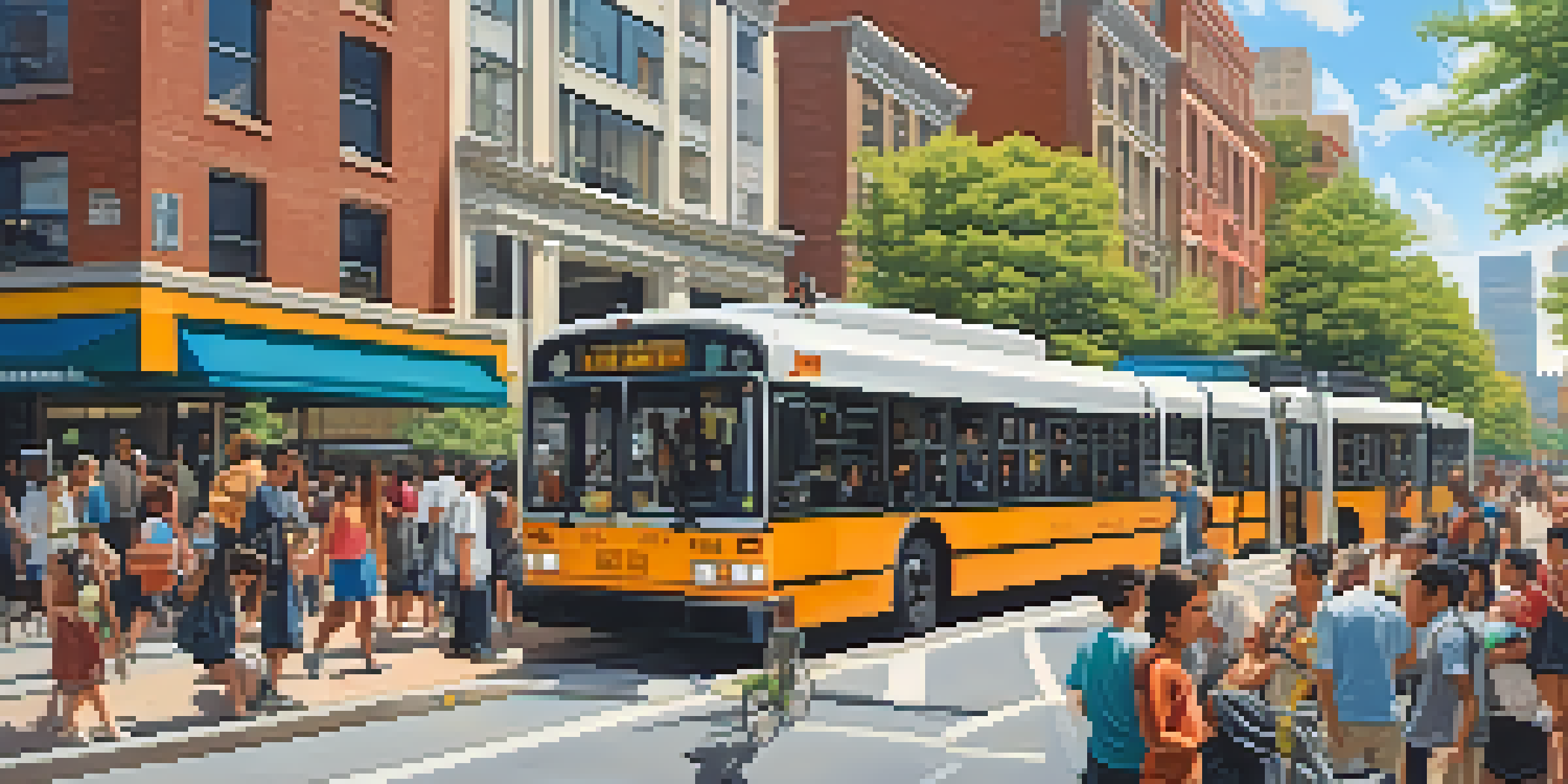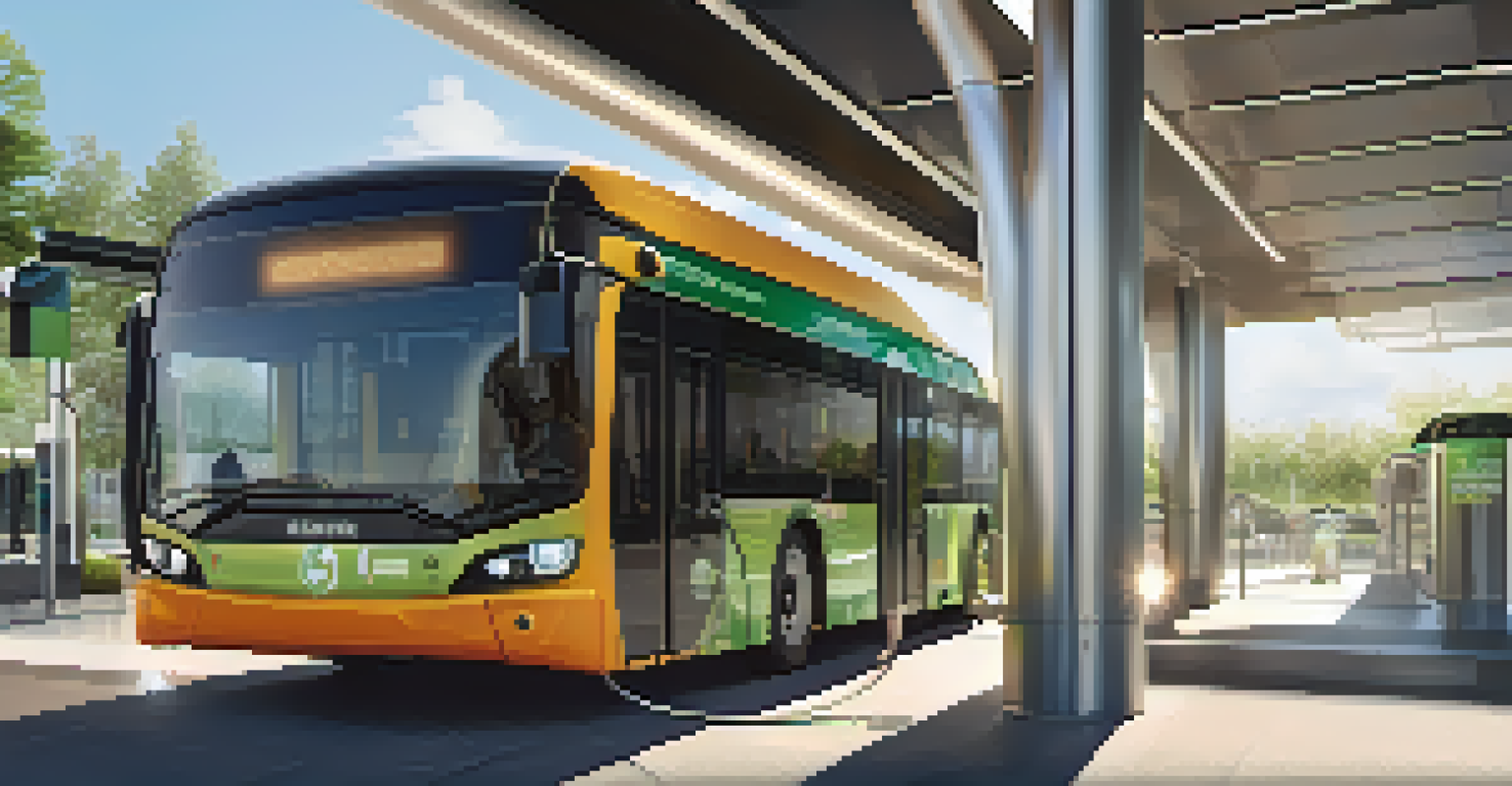The Role of Public Transportation in Sustainable Urban Growth

Understanding the Importance of Public Transportation
Public transportation is a crucial component of urban planning that connects people to jobs, schools, and essential services. Its significance extends beyond mere convenience; it serves as a lifeline, particularly for those without access to private vehicles. By providing reliable transit options, cities can create a more inclusive environment where everyone has the opportunity to thrive.
Public transportation is the backbone of any sustainable urban development strategy.
Moreover, effective public transport systems can reduce traffic congestion, making urban areas more navigable. When more people opt for buses, subways, or trams, the number of cars on the road decreases, leading to less pollution and a more pleasant urban atmosphere. Thus, public transportation not only facilitates movement but also enhances the quality of life in metropolitan areas.
In essence, recognizing the importance of public transportation is the first step toward fostering sustainable urban growth. As cities continue to expand, prioritizing public transit can pave the way for more resilient, equitable, and environmentally friendly communities.
Environmental Benefits of Public Transportation
One of the most significant advantages of public transportation is its positive impact on the environment. Buses and trains typically produce fewer emissions per passenger compared to private vehicles, helping to lower the overall carbon footprint of urban areas. This is crucial in tackling climate change, as cities are major contributors to greenhouse gas emissions.

Furthermore, public transport encourages people to reduce their reliance on fossil fuels. When cities invest in clean energy options for transit, such as electric buses or light rail systems, they further mitigate environmental damage. This transition not only helps combat pollution but also promotes a healthier lifestyle for residents, who benefit from cleaner air.
Public Transport Enhances Inclusivity
Public transportation connects individuals to essential services, promoting inclusivity and opportunity for all.
In summary, public transportation is a key player in the quest for environmental sustainability. By offering greener alternatives and reducing the number of cars on the road, cities can make significant strides toward a more sustainable future.
Economic Advantages of Efficient Public Transport
Public transportation systems can significantly boost local economies. By providing affordable and accessible transit options, cities attract businesses and encourage consumer spending. When employees can easily commute to their jobs, companies benefit from a more reliable workforce, leading to increased productivity and economic growth.
The best way to predict the future is to create it.
Moreover, investing in public transit infrastructure creates jobs, both during construction and in ongoing operations. This not only helps reduce unemployment but also fosters community development through improved services and amenities. A well-connected city can also draw in tourists, further enhancing its economic vitality.
Ultimately, the economic advantages of public transportation extend far beyond mere convenience. As cities prioritize efficient transit options, they lay the groundwork for robust and sustainable economic growth.
Social Equity and Public Transportation Access
Public transportation plays a vital role in promoting social equity within urban areas. By providing access to affordable transportation, it enables individuals from all backgrounds to engage in their communities and access crucial resources. This inclusivity is essential for fostering a sense of belonging and participation among residents.
For many low-income families, public transport is often the only viable means of travel. Without it, they may struggle to reach jobs, educational institutions, or healthcare services. By prioritizing equitable access to public transit, cities can help level the playing field and ensure that all residents have the opportunity to succeed.
Environmental Impact of Transit
Public transportation systems significantly reduce emissions, playing a crucial role in combating climate change.
In essence, public transportation is not just about moving people from point A to B; it's about creating a more equitable society where everyone has the chance to thrive. By investing in accessible transit systems, cities can help bridge the gap between different socioeconomic groups.
Urban Planning and Public Transportation Integration
Integrating public transportation into urban planning is essential for creating sustainable cities. Thoughtful design can ensure that transit options are conveniently located near residential and commercial areas, encouraging more people to use them. This not only reduces dependence on cars but also fosters walkable neighborhoods that promote healthier lifestyles.
Good urban planning also considers the entire transit network, including connections between different modes of transport. For instance, providing easy access to bike-sharing programs, pedestrian pathways, and transit hubs can create a seamless travel experience. This interconnectedness is crucial for maximizing the efficiency and effectiveness of public transport systems.
Ultimately, the integration of public transportation into urban planning leads to smarter growth. By designing cities with transit in mind, communities can become more vibrant, sustainable, and livable.
Challenges Facing Public Transportation Systems
Despite its many benefits, public transportation systems face a range of challenges that can hinder their effectiveness. Funding is often a significant issue, as many cities struggle to allocate sufficient resources for maintenance, upgrades, and expansions. Without proper investment, transit systems may become outdated and less reliable, driving people back to their cars.
Additionally, public perception can pose a challenge. Many individuals may view public transport as inconvenient or unsafe, leading to lower ridership. To combat this, cities need to prioritize improving the overall experience, ensuring that transit options are not only efficient but also comfortable and secure.
Economic Growth Through Transit
Investing in public transport not only boosts local economies but also creates jobs and attracts businesses.
Addressing these challenges is crucial for the future of public transportation. By tackling funding issues and enhancing the public perception of transit systems, cities can create more robust, reliable, and appealing options for their residents.
The Future of Public Transportation in Urban Growth
As cities continue to evolve, the future of public transportation holds exciting possibilities. Innovations such as autonomous vehicles, electric buses, and smart traffic management systems are set to revolutionize the way we think about transit. These advancements promise to enhance efficiency, reduce emissions, and improve the overall travel experience for users.
Moreover, integrating technology into public transportation can help cities better understand and respond to the needs of their residents. Real-time data on ridership patterns, for instance, can inform planning decisions and lead to more effective service delivery. This adaptability is essential for ensuring that public transport remains relevant in an ever-changing urban landscape.

In conclusion, the future of public transportation is bright, with the potential to drive sustainable urban growth. By embracing innovation and prioritizing the needs of communities, cities can create transit systems that truly enhance the quality of life for all residents.